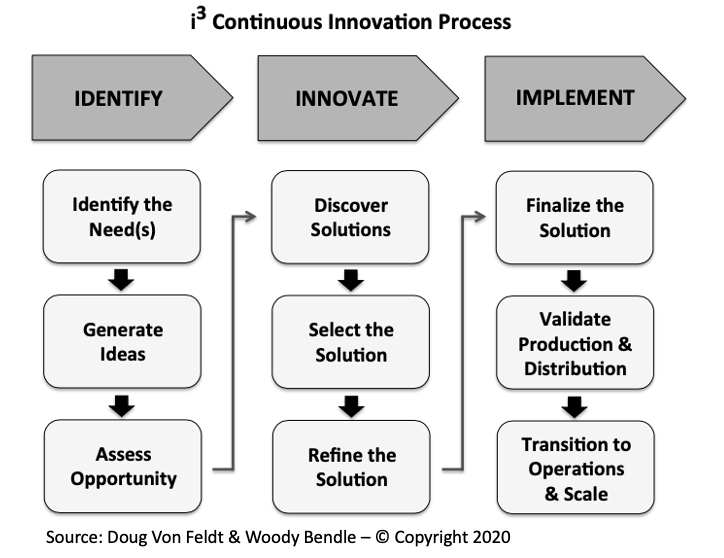I love double entendres!
In the same efficient breath, they can provoke so much thought! And in this instance, “Make Ideas Happen” represents two significant reasons for having an innovation strategy:
1) Systematically generate useful new ideas, and
2) Systematically taking new ideas through to prototype, concept testing and rollout (as illustrated by the i3 Continuous Innovation process graphic below) to fuel growth.

Mark Dodgson, in The Management of Technological Innovation, describes that the purpose of having an innovation strategy is to
“…help firms decide in a cumulative and sustainable manner, about the type of innovation that best matches corporate objectives… and guide decisions on how resources are to be used to meet a firm’s objectives for innovation and thereby deliver value and build competitive advantage.”
The role then of the Innovation Strategy is that of an aligning mechanism (plan) that can assist an organization in executing and achieving its overall growth strategy and goals.
But what exactly is Strategy? And what is an Innovation Strategy?
Strategy
I think most people commonly associate the term strategy with war, politics, sports and business.
When it comes to business, Gerry Johnson, Kevan Scholes and Richard Whittington in Exploring Corporate Strategy define strategy as the process that sets:
“…the direction and scope of an organization over the long-term: which achieves advantage for the organization through its configuration of resources within a challenging environment, to meet the needs of markets and to fulfill stakeholder expectations“.
Michael Porter in his seminal Harvard Business Review article “What is Strategy” (HBR subscriber content), states that “The essence of strategy is choosing to perform activities differently than rivals do. [And that] trade-offs are essential to strategy.”
And I truly love the following definition from the Merriam-Webster Dictionary:
“An adaptation, or complex of adaptations (as of behavior, metabolism, or structure) that serves or appears to serve an important function in achieving evolutionary success.”
How awesome is that!
“ACHIEVING… EVOLUTIONARY… SUCCESS!”
While there is A TON of literature out there on the topic of strategy (how to create, execute, monitor, etc.), from my experiences with actually creating strategies and overseeing strategy execution, I tend to think of strategy simply as:
The collective combination of things (resources and processes) that one purposefully employs (and chooses not to employ) in order to achieve some specific objective.
Or put another way, strategy is really just all the stuff you want and need to do to get something done, the way you want it done.
Creating Strategy
Creating a strategy can be challenging and messy. And it is often further complicated due to a lack of understanding about what strategy is… and isn’t.
People often confuse tactics with strategy and vice verse. They are not the same – at all!
As noted above, strategy is the combination of things (tactics) you need to do to get to where you are tying to go.
To create a strategy, I’ve found that it is useful to start by asking and answering the six following high-level questions:
- What do we want to achieve – and by when?
- Why do we want to do that?
- What all do we need to do (or might we do) in order to achieve our desired goal(s)?
- How do we best align and support our activities and resources to improve our odds of succeeding?
- What are different ways of allocating resources and efforts to achieve the same result?
- What external and internal factors could affect our ability to achieve our objectives?
The answers to the above (and other questions) become ingredients for your strategy.
While it isn’t my intention to fully detail the process of creating a strategy, I think David Aaker’s Developing Business Strategies is an excellent reference for those interested in taking a deeper dive.
In the end…
Over the years, I’ve found that the most critical starting point for creating a strategy is actually the end point. Jim Collins and Jerry Porras in “Building Your Company’s Vision” (HBR subscriber content) call this the “Envisioned Future“; or, to borrow another well-known expression from Stephen Covey, it means “beginning with the end in mind.”
So what Collins, Porras and Covey all assert is that once you know exactly where it is that you want to go, you can figure out a way to get there from where you are.
The flip side of this however is sheer madness. And, that might be a conversation that goes a little like this:
“Hey, we’re all here! So let’s do a bunch of stuff and go somewhere… big and awesome!
I’m not quite sure what or where that somewhere might be; so, let’s just keep doing all sorts of stuff until we figure it out.
I kinda like the way the guys over there are doing what they’re doing; and they seem to be getting somewhere…
Hey! Don’t sweat it! I’m pretty sure we’ll know when we actually get there… right?”
That remind anyone else of the many failed internet startup strategies from the mid-to-late 90’s…?
Which brings me back to why having an innovation strategy is so important.
Make Ideas Happen
Ideas are cool! Ideas are everywhere! Everybody has them. Some are really good. Some are really useful. And let’s admit it – some truly stink.
Unfortunately, good ideas aren’t often there when you want or need them either. But that doesn’t need to be the case. It shouldn’t be the case!
And, the COOLEST thing about ideas is when they are brought to life… and they actually work! Meaning they create new value – for you and your consumers! Which is exactly the point of an Innovation Strategy.
Look, nearly every organization out there has a stated objective of growth; they want to be bigger, and they want to make more money.
Innovation is that thing that fuels growth! And good ideas fuel innovation!
Thus, an Innovation Strategy is the thing (or plan) that helps your organization be innovative – continually. And the i3 Continuous Innovation Process (graphic at the beginning of this article) is the roadmap that enables systematic and sustainable innovation; creating a pipeline of new ideas that becomes the flywheel of growth. It Makes Ideas Happen!
I don’t know about you; but given all of the challenges so many organizations have encountered throughout the past several months, it sure seems like having an Innovation Strategy would make a lot of sense!
Now let’s go Make Some Ideas Happen!


Leave a Reply